Shark diving in South Africa without a cage is not for the faint of heart. But it offers an incredible chance to first hand observe one of the most misunderstood creatures on the planet. I guarantee it will change your perspective.
This was not my first time diving with sharks. I’ve dove with sharks in Honduras, Costa Rica, Galapagos, Red Sea and Palau – all with no cage! But it was my first time diving with Oceanic Black Tip Sharks and Ragged Tooth Sharks, affectionately called Raggies.
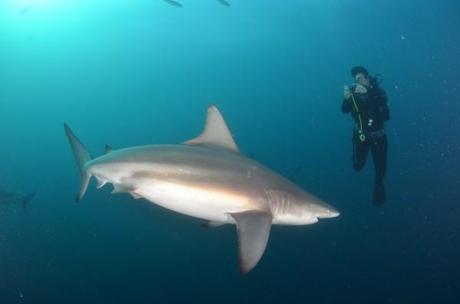
Me with an Oceanic Black Tip Shark. Photo courtesy of Joost van Uffelen.
J.P (my now German husband) and I met shark diving in Cocos, Costa Rica, so we knew that sharks would be part of our Wild South African and Swaziland Adventures. We were disappointed to learn that our chances of seeing Tiger sharks were almost nil, since Tiger shark season is typically from February-June and in October-November, but were still pumped to dive with sharks.
Our first shark dive was at Protea Banks with African Dive Adventures.
Protea Banks is known for its large quantities of sharks, but the tough part can be getting across the rough break. You hold on to the ropes that line the dinghy and hope for the best as you bounce up and brace yourself as you bottom hits down. I thought it was kind of fun, but not everyone shared my sentiments.
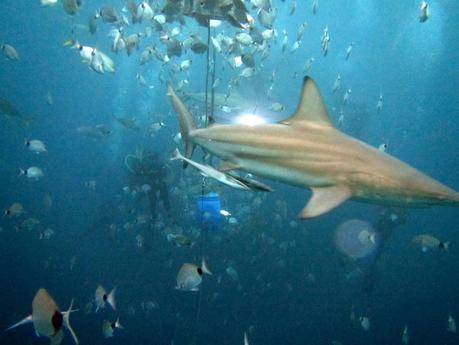
An Oceanic Black Tip shark expresses interest in the bait drum and the surrounding fish.
Once the break was cleared, the rest of the ride was smooth. We arrive at the pre-appointed spot by the dive team, who pours chum into the water – a mixture of blood and fish heads. Next,…we wait…There’s no point getting into the water and wasting valuable oxygen until the sharks have appeared. Fortunately they show up in a matter of minutes and we scramble to assemble our dive gear.
I’m always nervous when I begin a shark dive, especially at a new location. You never know who will be waiting for you below the surface…and how many of them.
But once I’m in the water, my fear dissipates and is replaced by awe and gratitude. I feel like the luckiest girl in the world to have the opportunity to observe sharks in their natural habitat. In this case it was seven Oceanic Black Tip Sharks, which run an average of 1.5 m (5 ft) but can get as big as 2.7m (9 ft). They definitely seem big to be, especially when there’s seven of them circling the bait bucket surrounded by small fish.
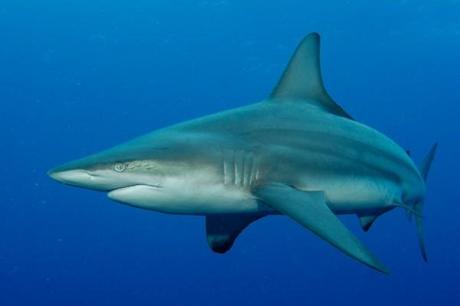
Oceanic Black Tip shark. Photo courtesy of African Dive Adventures.
My theory is that the sharks are just as curious about me as I am about them. They feign disinterest as they glide past me, but they don’t fool me. They didn’t get to be the top predator of the ocean without paying attention to the slightest detail, including my heart beat. Instead of scaring me, I am fascinated that they can sense how fast my heart is beating. I practice my yoga breathing – in part because I am relaxed and also because I want to prolong the dive as long as possible. More oxygen = longer dive.
My second dive at Protea Banks is EPIC! 17 Oceanic Black Tips!
Roland, one of the owners of African Dive Adventures was our skipper for this dive and sat this one out and is now regretting it. He has been diving these waters for 16 years and only rarely has seen so many Oceanic Black Tips on a dive. I had to ask the obvious question Have you seen any Great Whites? Only twice in about 500 dives comes the reply. I can’t decide whether I’m disappointed or relieved – remember there’s no cage.
After two great days of diving at Protea Banks we’re off to Aliwal Shoal, just further up the coast where we dove with Agulhaus House & Diving.
Aliwal Shoal is ranked as one of the top 10 dive sites in the world.
It’s known for its reefs…and its sharks. It’s Raggie season, so we’re hoping to see a cave full of Raggies. We see two. I’m delighted. They’re aptly named after their ragged teeth and look rather intimidating, but are docile – as far as sharks go.
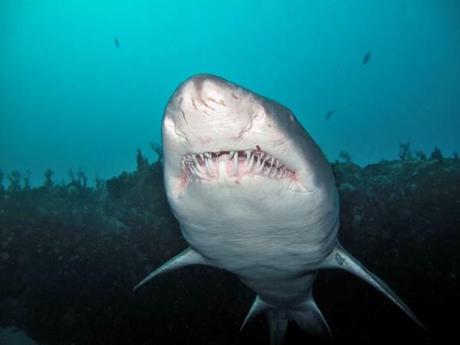
Ragged Tooth shark. Photo courtesy of African Dive Adventures.
Next up are the baited dives. More Oceanic Black Tips, an impressive 12 sharks make an appearance!
On our last dive, our dive master’s blue eyes grow big through his mask. That is either a really good or bad sign. He points frantically below us. I see a shadow. It disappears. Then reappears. Then disappears. The next time it reappears, I make out the rounded nose – a characteristic of a Bull Shark, or Zambezi Shark as they’re known locally. National Geographic reports that they are the most dangerous shark in the world. Even more dangerous than Great Whites or Tigers, who are also considered dangerous. They are known to be aggressive.
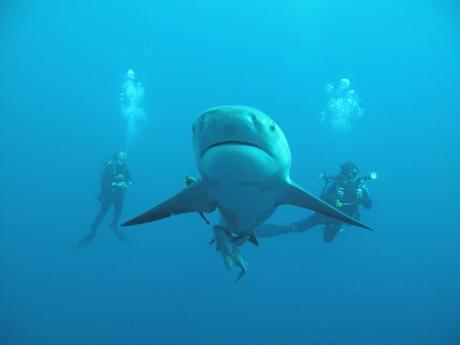
The Bull shark is considered by many experts to be the most dangerous shark in the world. Photo courtesy of African Dive Adventures.
It’s not my first time diving with Bull sharks, I dove with two of them in Costa Rica, and they fascinate me to no end.
But this shark has a secret. This shark, supposedly the most dangerous shark in the world, is shy. Painfully shy.
It forgoes the fish in favor of being cautious – keeping a distance of at least 5 meters between the divers and him. Remarkably another Bull shark joins him. This shark is also shy. I want him to come closer to tell him that I don’t bite. I’ll leave it your imagination to insert the obvious joke here. Neither of them does. They slowly swim deeper into the shadows until I can’t even make out a faint outline. Neither of them returns. But they did grace us with their presence on and off for 20 minutes.
Other divers are running out of oxygen and are surfacing. I notice the sharks interests shifts from the bait to the divers as they thrash around on the surface, taking off weight belts and fins. I’m completely enthralled. Before I know it, it’s only me and the dive master in the water. The sharks interest returns to the bait. They come closer to us, now that there are only two of us in the water. Perhaps they are feeling braver now that they outnumber us. I am overjoyed.
The five minutes I spend alone in the water with 12 Oceanic Black Tip sharks (and dive master) quickly becomes one of my all time diving highlights.
I slowly ascend, noticing the sharks ascending with me. I unclench my weight belt, hitting a shark in the nose with it as I swing it around – they are that close! Now I’m nervous. I feel perfectly safe diving with sharks, but get uncomfortable being at the surface where I can’t see them. I’m lifted onto the boat, too tired to jump unassisted.
On the way back to shore, I’m exhilarated and taunted by Roland’s final words to me;

